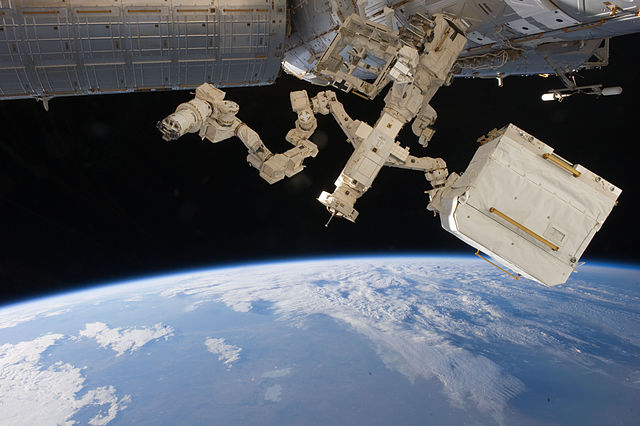Quick links
Dextre
> French dextre 'adroit'
DCHP-2 (Mar 2014)
n. — Science, Industry
a remote-controlled manipulator on the International Space Station (see Image 1).
Type: 1. Origin — Dextre was developed and built by a Canadian robotics company based in British Columbia (see the first 2003 quotation). It has two robotic arms which have a reach of 3.5 metres and together can handle up to 600 kg. It performs delicate maintenance work and repairs on the International Space Station and is part of the Mobile Servicing System, Canada's contribution to the ISS. Dextre can move on the Mobile Base System or be mounted on the end of Canadarm2 for further reach. It has been operational since 2008 (see the first 2008 quotation). See also the NASA reference.
Dextre and the Canadarm2 are featured on the reverse of the Canadian $5 bill, released in commemoration of Canada's achievements in space and long-time area of expertise in robotics (see the 2013 quotation).
Dextre and the Canadarm2 are featured on the reverse of the Canadian $5 bill, released in commemoration of Canada's achievements in space and long-time area of expertise in robotics (see the 2013 quotation).
See: Canadarm
Quotations
2003
After years of bearing the cumbersome moniker, "Special Purpose Dexterous Manipulator," the Canadian Space Agency has named the latest robotic arm that Canada's MD Robotics has built for the International Space Station "Dextre."
Dextre is the French word for the right hand. The two-armed robot will do external maintenance on the station.
2003
MacDonald, Dettwiler and Associates Ltd. says its MD Robotics subsidiary has won a $116-million contract to provide engineering services for the Canadian-made mobile servicing system on the International Space Station.
The contract with the Canadian Space Agency will see MD Robotics work on the software of orbiting Canadian robotic components, as well as the development, testing and integration of the MBS with Dextre, a multi-functional robot.
MD Robotics will also provide spare equipment and overall technical support on the ground.
The company already has robotics at the station that include Canadarm2, installed in 2002.
2007
MacDonald Dettwiler and Associates Ltd., a provider of specialized information and space technology, says it has signed a contract amendment worth $8.7-million with the Canadian Space Agency to back continuing work on a space robotic arm called Dextre for use on the International Space Station. The technology is part of the so-called Mobile Servicing System, Canada's contribution to the space station. The Canadarm2 and Dextre robotic arms used on the mobile system are built and serviced by MDA under contract to the CSA.
2008
Touted as the most sophisticated robot system to go into space, Dextre is expected to be hoisted into orbit by a space shuttle early this year, in what will be a highlight for the Canadian space program in 2008.
It will be Canada's final hardware contribution to the international Space Station, a complement to the orbital complex's highly praised Canadarm2 robot crane system. [...]
Roughly the size of a pool table, Dextre is a clunky-looking robot with two articulated hands.
Dextre will enable the crew of the space station to perform repairs and maintenance operations without having to leave their pressurized modules. It can be operated either from a console inside the space station, or by ground controllers.
It will be moved around the space station by Canadarm2, which has a reach of 17 metres.
2008
Space engineers are anxious to see their latest toy perform now that Dextre the Canadian robot is fully assembled on the International Space Station.
Astronaut Julie Payette told a briefing at the Canadian Space Agency near Montreal that assembly of the $200-milion robot was completed Monday night during the last of three spacewalks.
2013
New polymer $5 and $10 bills were revealed by the Bank of Canada.
Images on the bills include the Canadarm2 and Dextre-robotics innovations used to build and maintain the International Space Station on the $5 bill and an image of the Canadian train traveling around the Rocky Mountains on the $10 bill. Orbiting more than 350 kilometres above the Earth, Canadian astronaut Chris Hadfield showed off the new $5 bill. The front of the $5 features a portrait of Sir Wilfrid Laurier, prime minister of Canada from 1896 to 1911.
References
- NASA • "Dextre"
Images
